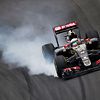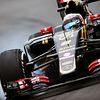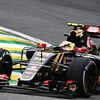Technical analysis: Lotus E23
Lotus has followed its fellow Mercedes powered teams in designing a car with a very short nose cone. Featuring no thumb, a rather thick point and a nose as narrow as they could possibly make it, the nose cone itself is extremely similar to the 2015 Mercedes design. For starters, that can't be all that bad.
For Lotus however, it will have been a major task to adapt the rest of their design philosophy to it, as the new nose will work the airflow entirely differently than the twin tusk design on the Lotus E22. The team's test of an interim version of this nose last season proves they've been working on it for quite some time already.

On the suspension front, the team have surprisingly moved the steering arm upward, now as a separate element instead of having it aligned with the lower front wishbone. This is against the trend, as Mercedes moved theirs down to the bottom while Toro Rosso aligned it with the upper wishbones to reduce drag. The reduced cross section at the front bulkhead - due to the reduction of the volume of the vanity panel that sits above the monocoque at this point - may have played a role in that, possibly forcing the team to move the steering rack to any location it could find space, without having to relocate too much of the other suspension components.
Of course, the main challenge for Lotus has been the integration of the Mercedes power unit. This one is confirmed to have larger headers due to the addition of variable inlet trumpets this year, the use of a tubular exhaust manifold along with a rumoured increase of heat rejection from the more powerful Mercedes PU106B power package.
All things combined, this has resulted in fairly rounded sidepods, but still packaged so tightly that the position of the radiators is obvious from looking at it. Having seen the Lotus uncovered in the pitlane however, I'm 100% certain of this position.

The different location of cooling components has also resulted in a larger inlet scoop in the airbox, with the team uniquely opting to have four separate inlets, rather than the commonly seen split airbox this year. An image that appeared on Tuesday at Jerez has meanwhile also confirmed that the main inlet feeds the engine's turbo while the left and right inlets are connected to channels that wrap around the airbox, feeding an oil cooler that sits behind the air filter of the airbox. Finally, the smaller circular inlet on the car's centreline is likely used to cool components lower down in the car, likely some electrical components that are part of the ERS system.

Just like what most other teams have done, Lotus similarly paid attention to the flow conditioners above and aside the sidepods as these are crucial for rear downforce generation. Their new version features a sharper curvature on the outer edges of the car, similar to the Ferrari Formula One cars of last and this year.
It is also good to see that the team has finally got rid of its assymetry on the rear of the car with a central rear wing support and hot air exists that resemble those of the Red Bull RB10, even though they run further to the back, visible thanks to the protruding rear suspension elements.
Of course, just like most other cars, this one will change aerodynamically at the final test. Proof of that are the front and rear wings as run at Jerez as those are identical to the ones seen at the final 2014 test at Abu Dhabi.







